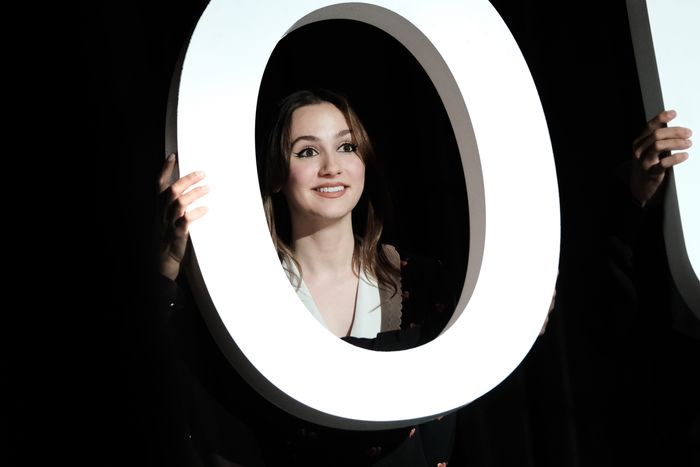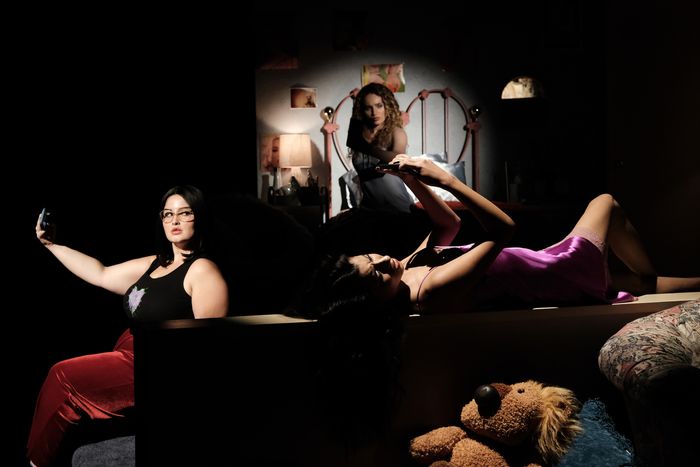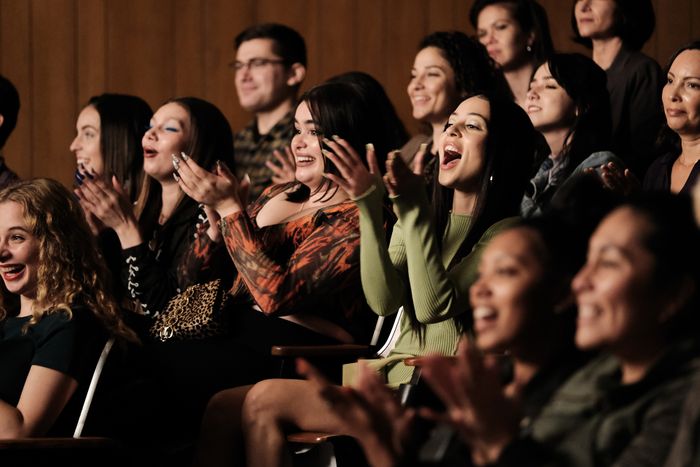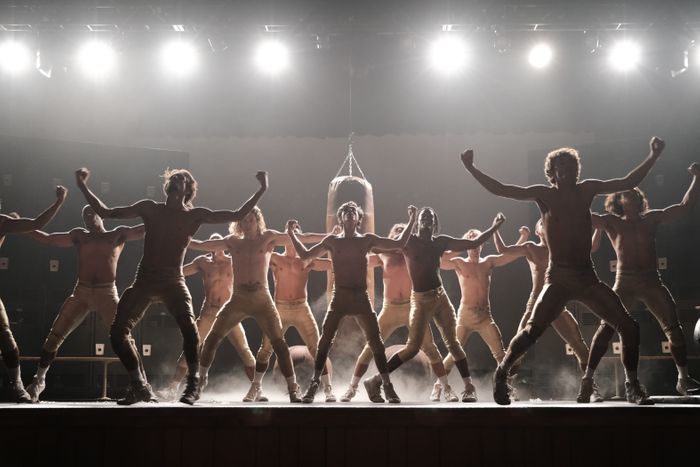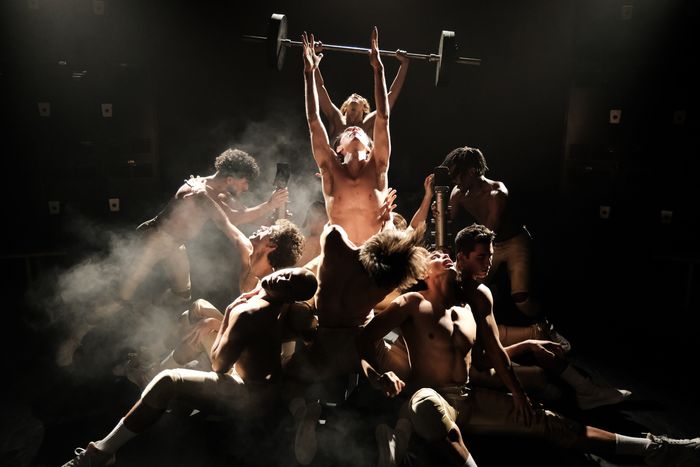
Lexi Howard (Maude Apatow) spent much of the first season of Euphoria waiting in the wings. After watching her best friend, Rue (Zendaya), spiral into addiction and her sister, Cassie (Sydney Sweeney), pine for emotionally unavailable men, Lexi gets her moment in the spotlight in season two. The quiet observer has been teasing her brainchild, a school play that will show the events of the hit HBO show through her eyes, since the season-two premiere. When her burgeoning love interest, Fezco (Angus Cloud), asks what the play is about, Lexi describes it as a story “about friendship,” though her interpretation proves to be more complicated than that.
In Sunday’s penultimate episode of the season, it’s finally showtime. The hour is a technical feat, seamlessly weaving in and out of Lexi’s memories and an extravagant stage production depicting her perception of the lives of her classmates — including multiple sets, a rotating turntable, and hyperdetailed costumes and styling. Titled Our Life, the play examines Lexi’s desires and observations up close, jumping from Rue’s father’s funeral, where she realizes the depth of her best friend’s dependency on drugs, to happy memories of her now-broken family. The finale stages an overtly queer musical number set to Bonnie Tyler’s “Holding Out for a Hero,” featuring a pseudo-Nate played by Kat’s ex, Ethan (Austin Abrams). Early in the play, Maddy (Alexa Demie) whispers to Kat (Barbie Ferreira), “Is this fucking play about us?” And indeed it is, though the staged version has an added bite aimed at Cassie and Nate; the play (and the episode) ends with him storming out of the auditorium before dumping Cassie.
The time- and perspective-bending episode required diligent planning for the behind-the-scenes creatives — including but not limited to the camera, costume, hair and makeup, and production-design departments — in order to blur the lines between truth and fiction. Here’s how they tweaked their usual process to bring Lexi’s vision to life.
Leaning into Lexi
Our Life is a heightened version of events we’ve seen unfold over two seasons, employing a host of doppelgängers to stand in for Rue (Aja Bair as “Jade”), Cassie (Eden Rose Ginsberg as “Hallie”), Maddy (Izabella Alvarez as “Marta”) and Kat (Isabella Amara as “Luna”). Ethan delightfully embodies everyone from Suze Howard to “Jake,” i.e., Nate — who, after inviting Cassie to move in with him at his parents’ house in episode six, has taken over her life completely. While it’s unclear whether Lexi knows about Nate’s upbringing or his dad’s dalliances with men, her disdain for her sister’s boyfriend is now documented for the entire school.
Writer-director Sam Levinson wanted exaggerated versions of the core characters for the play. That’s most prominent in the portrayal of Lexi and Cassie’s sibling relationship, which positions Cassie’s life (mainly her body) as aspirational. In her first speaking appearance onstage, fake Cassie descends from the rafters to the stage in a circular throne — as if literally from the heavens like an angel, complete with enormous feather wings and ethereal backlighting — as Lexi laments that her life’s defining moment is when her older sister went through puberty. “It’s obvious that Lexi has a certain position on how she feels about her sister,” said costume designer Heidi Bivens, who dressed Ginsberg in an all-white, cleavage-baring ensemble to play into Cassie’s innocent facade. “Cassie is the Malibu Barbie, but we also see Lexi coming into her own,” said hair stylist Kim Kimble. Throughout the season, Lexi has been getting progressively bolder with her makeup looks and hairstyles. Kimble and head makeup artist Doniella Davy pulled inspiration from Twiggy and other retro influences, adding bangs, braids, and more pronounced eye makeup to the character’s everyday looks, which in turn inspire Lexi’s rising self-confidence.
For the rest of the ensemble, Davy remixed memorable season-one looks; faux Kat’s season-one Halloween look got updated with green eye shadow from the carnival episode to create the doppelgänger’s school-photo moment onstage. The refreshed looks not only provide new visuals but give us a peek into Lexi’s interpretations of who her classmates are. “That imitation version of them feels more subtle, more refined, and more moody instead of bright and uplifting,” Davy said.
While a typical episode of Euphoria is told from Rue’s perspective, that framing is reduced in “The Theater and It’s Double.” Instead, we’re treated to Lexi’s point of view for most of the running time. The crossover between reality and fiction “was really important to nail in terms of the play sets looking very close to the real sets but also doing our own take on how it might look different in Lexi’s version,” set decorator Julia Altschul said. “Because Lexi is a more organized person, we felt Lexi would represent things in a more contained way.” In previous episodes and scenes — especially Cassie’s hysterical getting-ready montage in episode three — Altschul filled the Howard sisters’ bedroom with more furniture and clutter to symbolize Cassie’s state of mind. But Lexi’s play set, with two beds, a sofa, and closets, does just enough to communicate the setting without feeling overwhelming.
Though the sets morphed to inhabit Lexi’s perspective, the visual language of the episode didn’t depart too far from the show’s typical form. “It’s a very subjective point of view, but the whole show is a very subjective point of view. Even Lexi’s perspective doesn’t necessarily make it a realist perspective,” said director of photography Marcell Rév.
A theatrical sensibility
That this episode unfolds through the lens of a play was not lost on the crew, which pulled many lighting and set cues from theater techniques. “That high-contrast light and shadow throughout the episode is based on the fact that in theater, you light something from a distance with spotlights. We tried to apply that to certain scenes that were not set on stage,” Rév said, referencing shots of Kat camming and Maddy silhouetted in Nate’s dream sequence as well as a scene in which the streetlights turn off one by one as Rue and Lexi walk home.
Those lighting choices affected the type of film stock used on a scene-by-scene basis. Stage scenes used a traditional Kodak film stock, which works better with lighting that already has contrast in it (as stage spotlights do), while those set in the real world employed the Ektachrome film stock used throughout the rest of the show. Rév underexposed the Kodak stock as it was developing so it would match the overall look of the series. Speed was also top of mind with shots borrowing from the frenetic energy of theatrical productions to ratchet up the tension. “We wanted to use the behind the scenes of the play — the rush and anxiety of being backstage — and stretch it out to the real-life events,” he said.
Because the typical Euphoria makeup is already heightened for most of the characters, Davy used the play as an opportunity to give Lexi, whose regular looks tend toward subtle compared with her peers, more pronounced stage makeup. In addition to Lexi’s now-signature red lip, Davy added stylized spikes on her eye that feel bigger than her typical look. “It’s a stage look, so it could be a little bit out of Lexi’s everyday comfort zone,” Davy said.
But not everything lined up with the realistic parameters of a high-school play. If you’re wondering why the end product rivaled the sophistication of a Broadway-level production, the crew was conscious of that decision. “We threw out the rules of keeping the set at a high-school level,” production designer Jason Baldwin Stewart said. “It was more interesting to just see what we could do.”
Rév added, “I wanted to have the goofiness of the play, like dropping the letter in the beginning. It’s not perfect; it’s more like an ideal version of how the students imagine a play they put on would look. Because the whole show is not based in realism, we let ourselves be free with that.”
Setting the scene
Stylistically, “The Theater and It’s Double” suspends reality, asking viewers to follow the jumps between the real world and the performance. A scene will start in Lexi’s memory with the real Cassie but pan to reveal Hallie, who completes the scene on stage. While a lot of the magic came together in editing, the groundwork was set by the crew, and conversations about sets started five to six months prior to filming. Despite having different time periods at play in the episode, Rév wanted to make sure the look and feel was cohesive so it never felt like separate timelines. The spaces between the play’s events and the actual events were connected via sets and set dressing, allowing the camera movement to tie the story together.
Stewart and his team built play duplicates of every set, occasionally taking apart existing sets and reconstructing them on Lexi’s stage and often removing walls or mirror glass to allow for more fluid camerawork. “We had one set where we wanted to pass through the window and then pivot without cutting to reveal the audience. I couldn’t revise our existing set; I had to build a new set that I could [move] off the stage.” Stewart and his team created movable walls throughout the stage so a camera could push easily from behind a set and into the audience, and they brought out the front of the stage so the center elements of the play would feel closer to the audience. The turntable — used for an alternate-reality scene in which Lexi isn’t the school wallflower — was a late addition engineered by Stewart over a four-day break in the play-filming schedule. The crew tore out the existing stage, dropped in the turntable, reskinned the stage, and put the sets back on top.
In order to give the camera easy access from the stage to the seats, the auditorium had to be built from scratch. “We needed to have access to the auditorium through the back of the stage and side stages and manipulate the stage a lot. We were on location” — at Dorsey High School in Los Angeles — “for a very brief amount of time, and we used that auditorium as a reference to build out ours on a stage,” Altschul said. She and Stewart flew across the country to find seats to fill the 290-person set they were building, aiming for a wooden construction with gold detailing to match Lexi’s production design. At an auction, they found seats with a little chrome-metal strip on top, which would attract light when the rest of the auditorium fell to black. “It gave us so many opportunities to have motion with the other sets,” said Stewart. “We had freedom to cover the play in many angles, where you could look at a full audience and see the eyelines from different characters looking across to one another. You can stay in that world of the play, but you always have a sense of the audience.”
Holding out for a hero
The episode crescendos in an uproarious, energizing locker-room musical number performed by Ethan as Nate and a slew of background dancers serving as his teammates. In a two-minute choreographed scene, Ethan prances around stage, pumping iron suggestively, thrusting, and dancing on a phallic punching bag. At first, Levinson considered cutting it in half given the long running time. “The length was unheard of for TV,” said choreographer Ryan Heffington, “but I was like, ‘Just watch it again.’ And Sam watched it again and was like, ‘You’re right. There’s no way we can edit this.’”
Aside from zeroing in on the song, the original scripted version was fairly vague, according to Heffington. “There was a lot of body oil and rubbing, which we couldn’t do because of the slickness of the stage and the hazard to the dancers.” Heffington substituted those elements for more bumping-and-grinding choreography. High-school boys are “so virile at that point, and I wanted it to feel like high school — being horny 24 hours a day.” Ethan’s playfulness is central to the scene. “Austin and I talked about how, if Nate could possibly live out his fantasies, this is what it would be. It felt like a fever dream — no, more like a wet dream,” Heffington said. The goal was to make the performance as over-the-top as possible. “I used ‘mad scientist’ as a direction for Austin,” he said. “He should be filled with this teenage horniness and excitement about sex.”
Matching Ethan’s hair to that of Nate’s was top of mind for Kimble’s team. “It didn’t feel like a wig moment, especially with all of that dancing, so we took a temporary color and painted his hair darker every day,” said Kimble. In costuming, Levinson originally envisioned the musical number performed in a sea of tighty-whities, but Bivens thought it’d be funnier if the actors looked naked. “I wanted to get skin-tone football pants for each actor, but getting the skin tone right was complicated. Then we tried a light-gold metallic, which felt like high-school theater. It worked.”
Save for some weight stations and oversize lockers that are backlit with silhouettes, the set is relatively bare, though the process remained true to the collaborative spirit of the show. Heffington conceptualized the erotic punching bag, the squirting water bottles, and the lockers, which were then handed over to Stewart and Altschul to execute. “Instead of using literal lockers, I thought, Why not grow them?” Stewart said. His team rigged them to open at the same time with a musical cue. Stewart had originally imagined a center scenery set piece that utilized the turntable but ultimately pared it back to allow the choreography to shine.
The energy of the sequence onscreen ultimately mirrored that of the filming, and watching it come to life was a highlight for the entire crew. “Everyone was beaming and in tears. It felt like a live performance,” recalls Bivens. “Like theater.”


